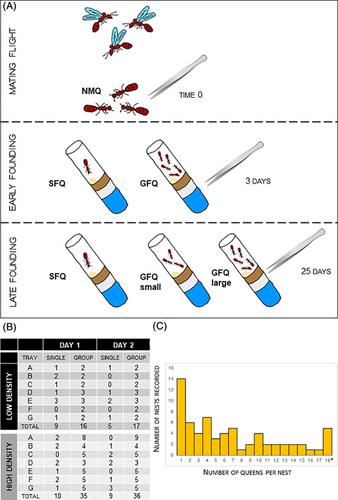当前位置:
X-MOL 学术
›
Genes Brain Behav.
›
论文详情
Our official English website, www.x-mol.net, welcomes your
feedback! (Note: you will need to create a separate account there.)
Social isolation and group size are associated with divergent gene expression in the brain of ant queens
Genes, Brain and Behavior ( IF 2.4 ) Pub Date : 2021-06-07 , DOI: 10.1111/gbb.12758 Fabio Manfredini 1, 2 , Carlos Martinez-Ruiz 3 , Yannick Wurm 3 , De Wayne Shoemaker 4 , Mark J F Brown 2
Genes, Brain and Behavior ( IF 2.4 ) Pub Date : 2021-06-07 , DOI: 10.1111/gbb.12758 Fabio Manfredini 1, 2 , Carlos Martinez-Ruiz 3 , Yannick Wurm 3 , De Wayne Shoemaker 4 , Mark J F Brown 2
Affiliation

|
Social life and isolation pose a complex suite of challenges to organisms prompting significant changes in neural state. However, plasticity in how brains respond to social challenges remains largely unexplored. The fire ants Solenopsis invicta provide an ideal scenario for examining this. Fire ant queens may found colonies individually or in groups of up to 30 queens, depending on key factors such as density of newly mated queens and availability of nesting sites. We artificially manipulated availability of nesting sites to test how the brain responds to social versus solitary colony founding at two key timepoints (early vs. late colony founding) and to group size (large vs. small groups). We adopted a powerful neurogenomic approach to identify even subtle differences of gene expression between treatment groups, and we built a global gene co-expression network of the fire ant brain to identify gene modules specifically associated with the different components of the social environment. The difference between group and single founding queens involves only one gene when founding behavior is still plastic and queens can switch from one modality to another, while hundreds of genes are involved later in the process, when behaviors have lost the initial plasticity and are more canalized. Furthermore, we find that large groups are associated with greater changes in gene expression than small groups, showing that even potentially subtle differences in the social environment can be linked to different neurogenomic states.
中文翻译:

社会隔离和群体规模与蚁后大脑中不同的基因表达有关
社会生活和孤立对生物体提出了一系列复杂的挑战,促使神经状态发生重大变化。然而,大脑如何应对社会挑战的可塑性在很大程度上仍未得到探索。火蚁Solenopsis invicta提供一个理想的场景来检查这个。火蚁蚁后可能会单独或以最多 30 个蚁后为一组找到蚁群,具体取决于关键因素,例如新交配蚁后的密度和筑巢地点的可用性。我们人为地操纵了筑巢地点的可用性,以测试大脑在两个关键时间点(早期与晚期殖民地建立)和群体规模(大群体与小群体)对社会与孤独群体建立的反应。我们采用了一种强大的神经基因组学方法来识别治疗组之间基因表达的细微差异,并且我们构建了火蚁大脑的全球基因共表达网络,以识别与社会环境的不同组成部分具体相关的基因模块。当创始行为仍然是可塑的并且蚁后可以从一种模式切换到另一种模式时,群体创始蜂王和单一创始蜂王之间的差异仅涉及一个基因,而在该过程的后期,当行为失去最初的可塑性并且更加渠道化时,涉及数百个基因. 此外,我们发现,与小群体相比,大群体与基因表达的更大变化相关,这表明即使是社会环境中潜在的细微差异也可能与不同的神经基因组状态相关联。
更新日期:2021-06-07
中文翻译:

社会隔离和群体规模与蚁后大脑中不同的基因表达有关
社会生活和孤立对生物体提出了一系列复杂的挑战,促使神经状态发生重大变化。然而,大脑如何应对社会挑战的可塑性在很大程度上仍未得到探索。火蚁Solenopsis invicta提供一个理想的场景来检查这个。火蚁蚁后可能会单独或以最多 30 个蚁后为一组找到蚁群,具体取决于关键因素,例如新交配蚁后的密度和筑巢地点的可用性。我们人为地操纵了筑巢地点的可用性,以测试大脑在两个关键时间点(早期与晚期殖民地建立)和群体规模(大群体与小群体)对社会与孤独群体建立的反应。我们采用了一种强大的神经基因组学方法来识别治疗组之间基因表达的细微差异,并且我们构建了火蚁大脑的全球基因共表达网络,以识别与社会环境的不同组成部分具体相关的基因模块。当创始行为仍然是可塑的并且蚁后可以从一种模式切换到另一种模式时,群体创始蜂王和单一创始蜂王之间的差异仅涉及一个基因,而在该过程的后期,当行为失去最初的可塑性并且更加渠道化时,涉及数百个基因. 此外,我们发现,与小群体相比,大群体与基因表达的更大变化相关,这表明即使是社会环境中潜在的细微差异也可能与不同的神经基因组状态相关联。











































 京公网安备 11010802027423号
京公网安备 11010802027423号